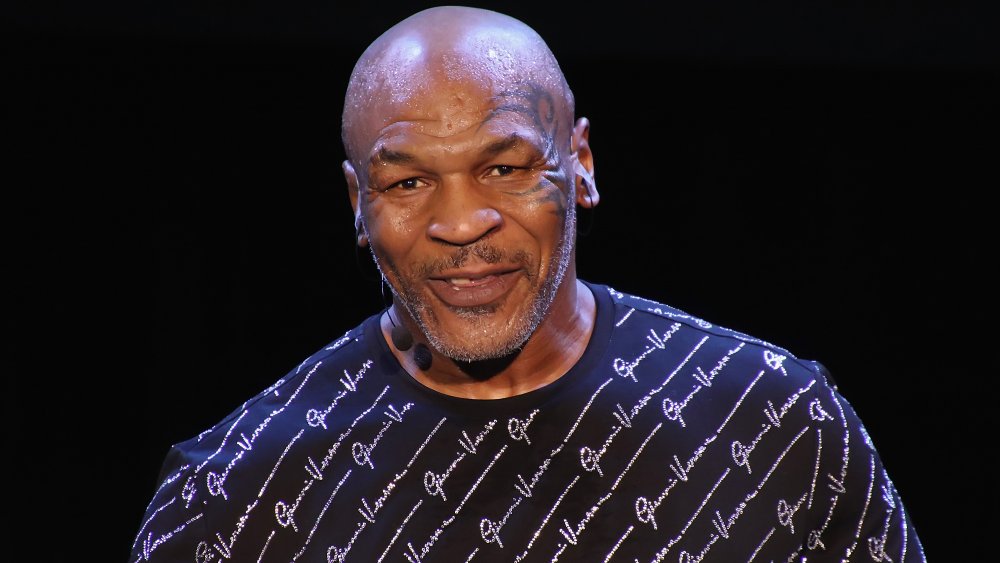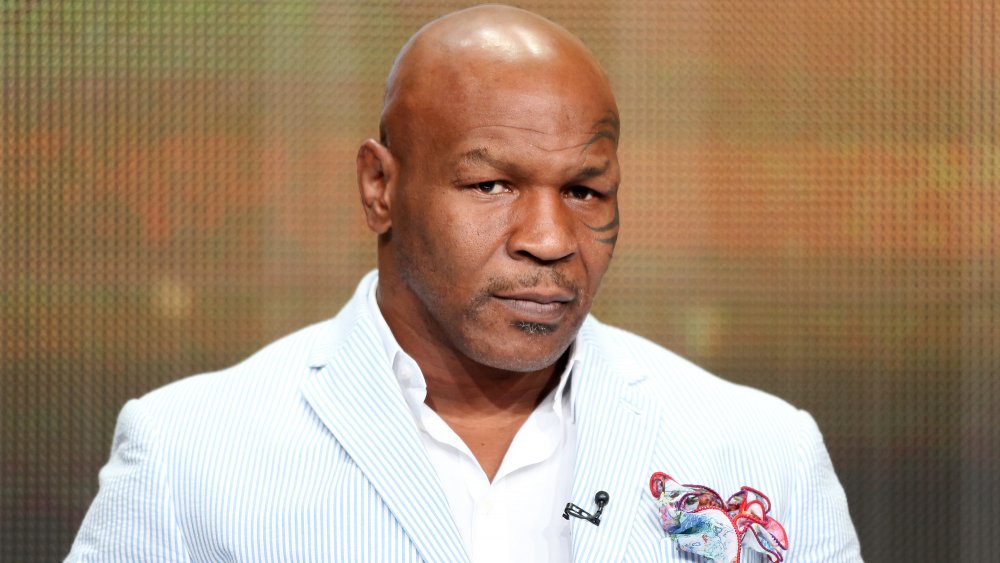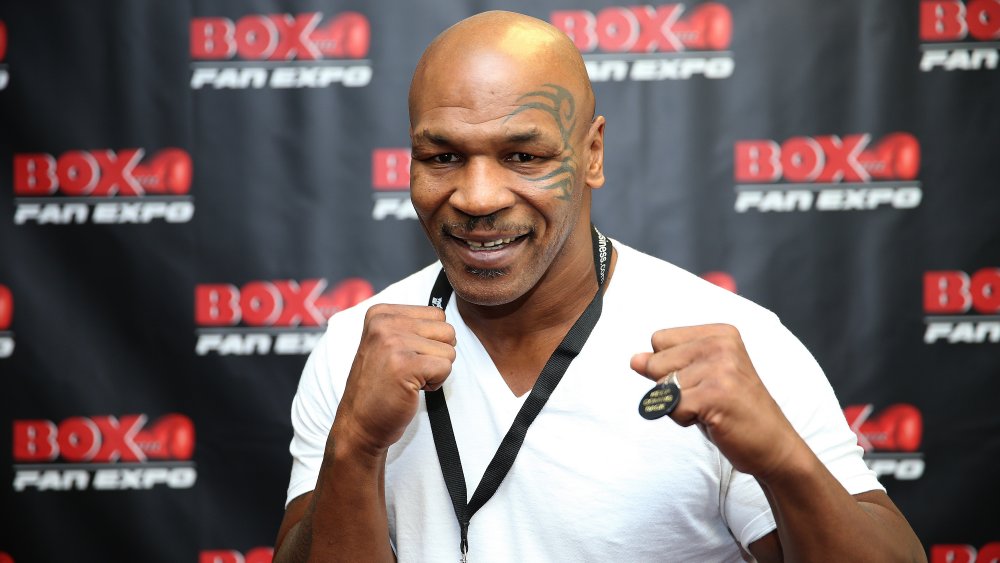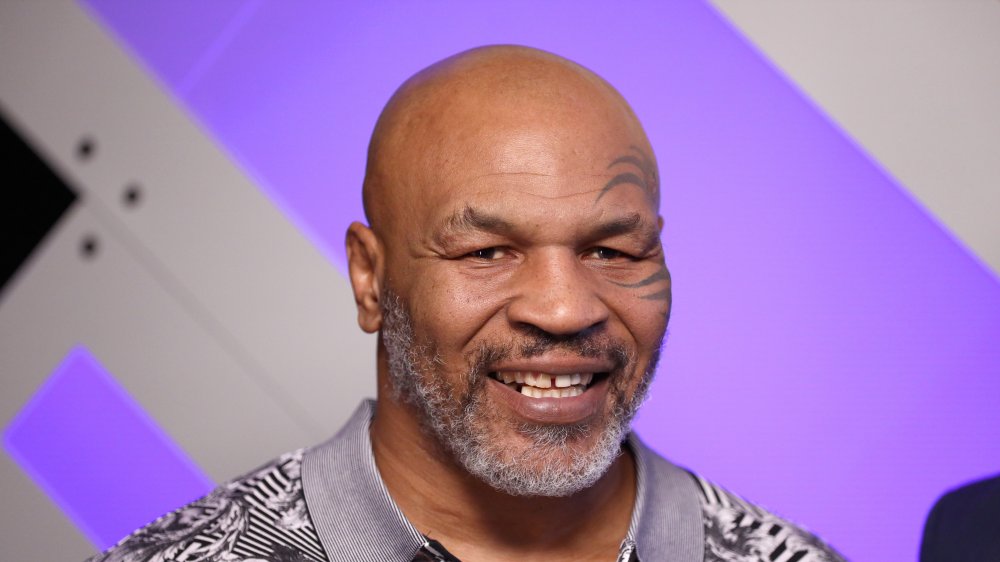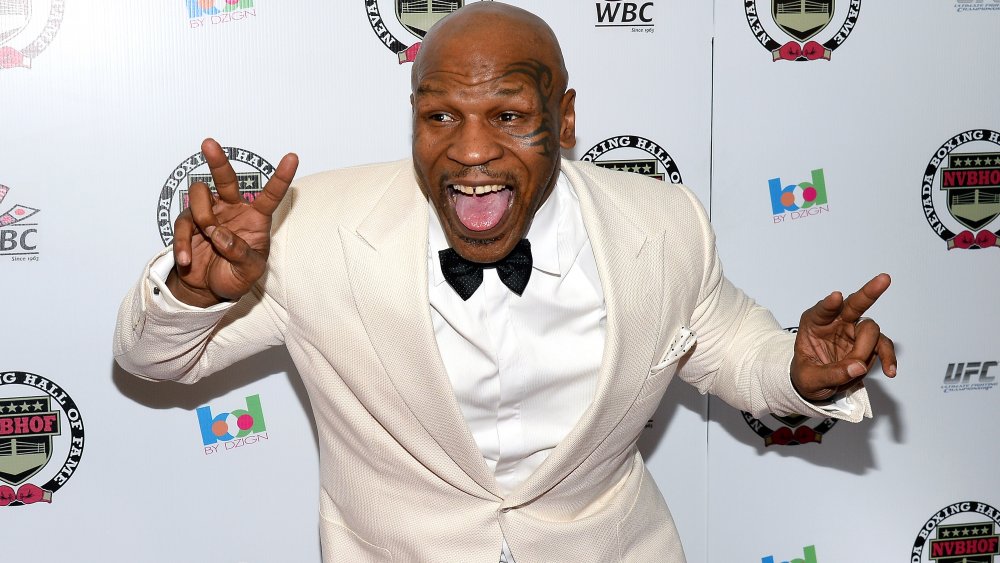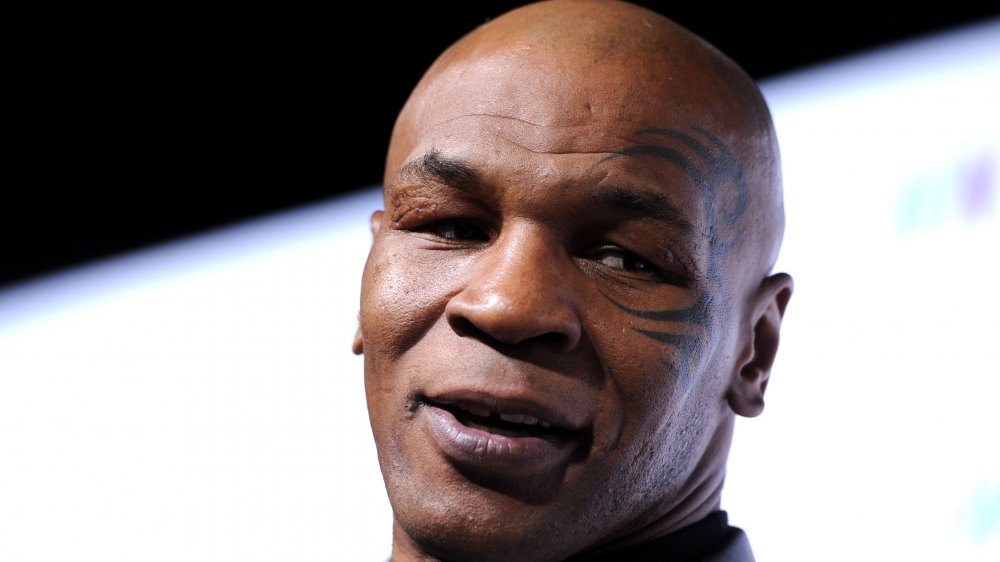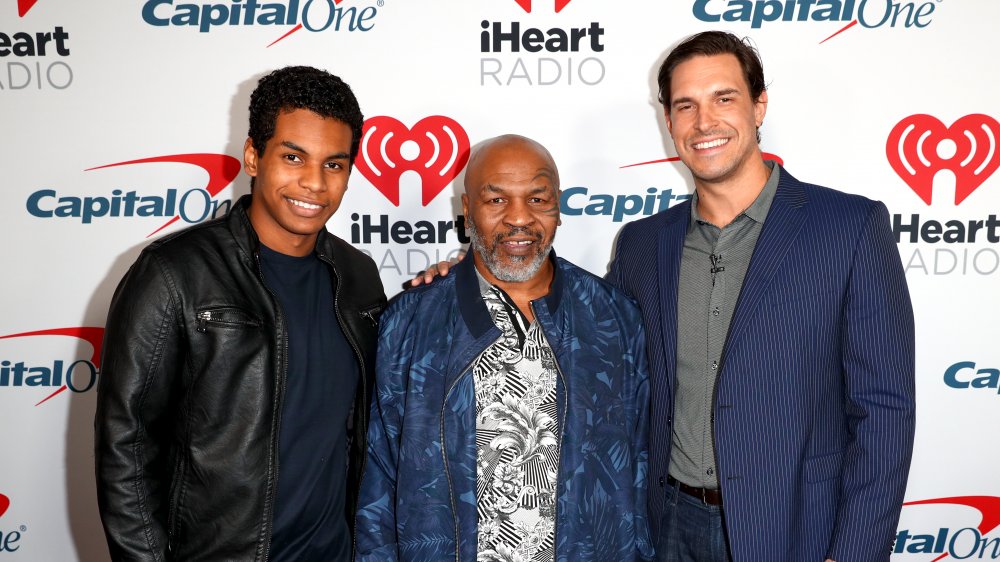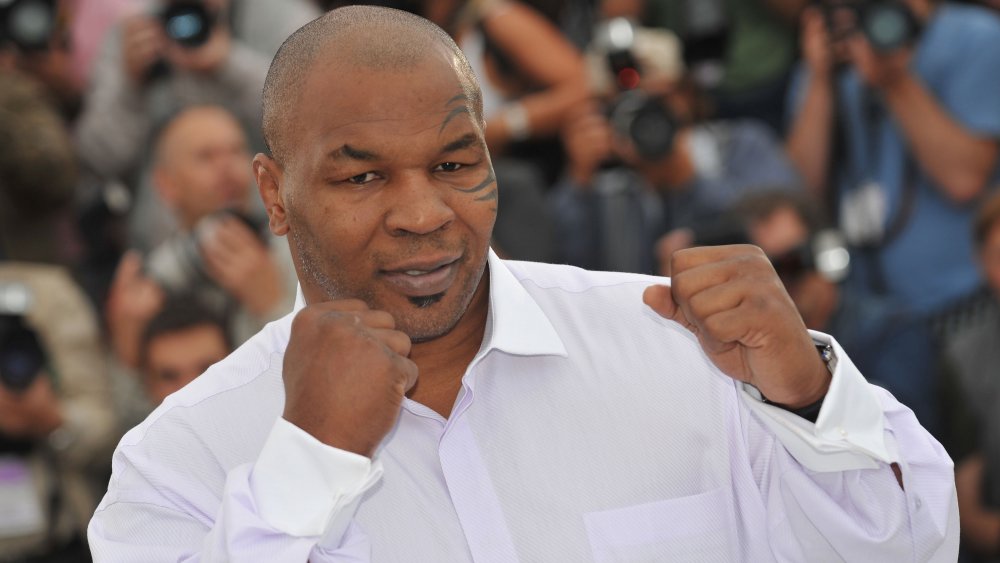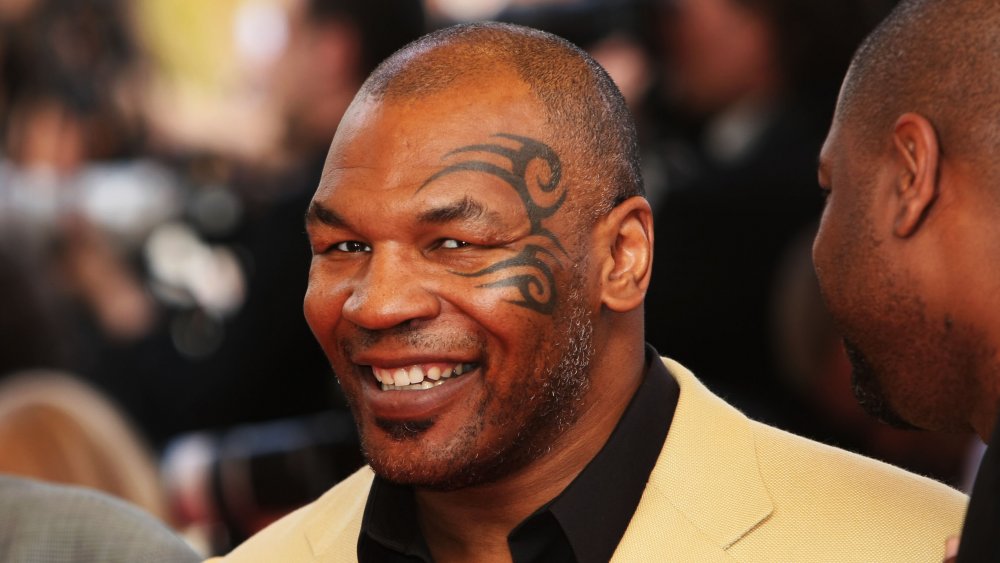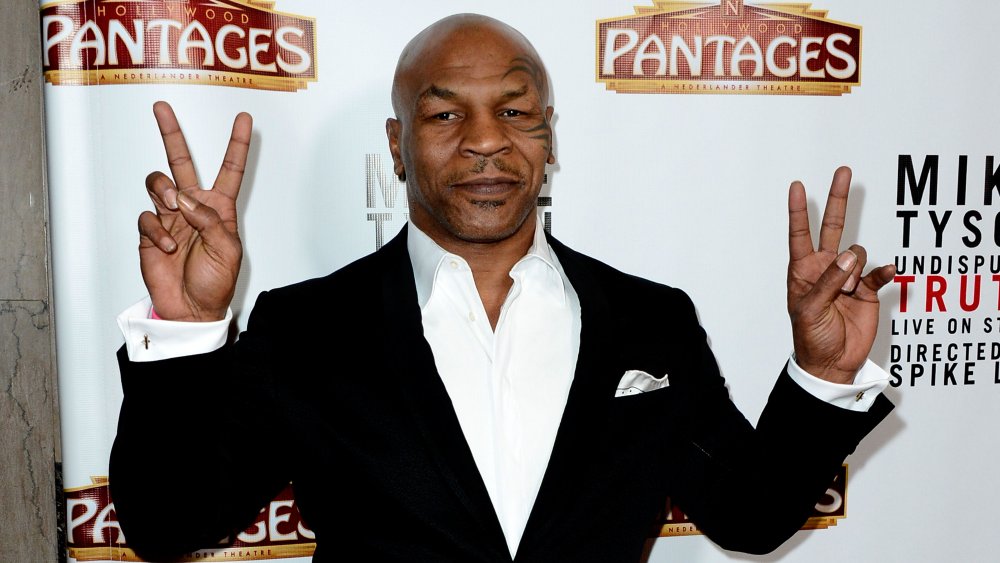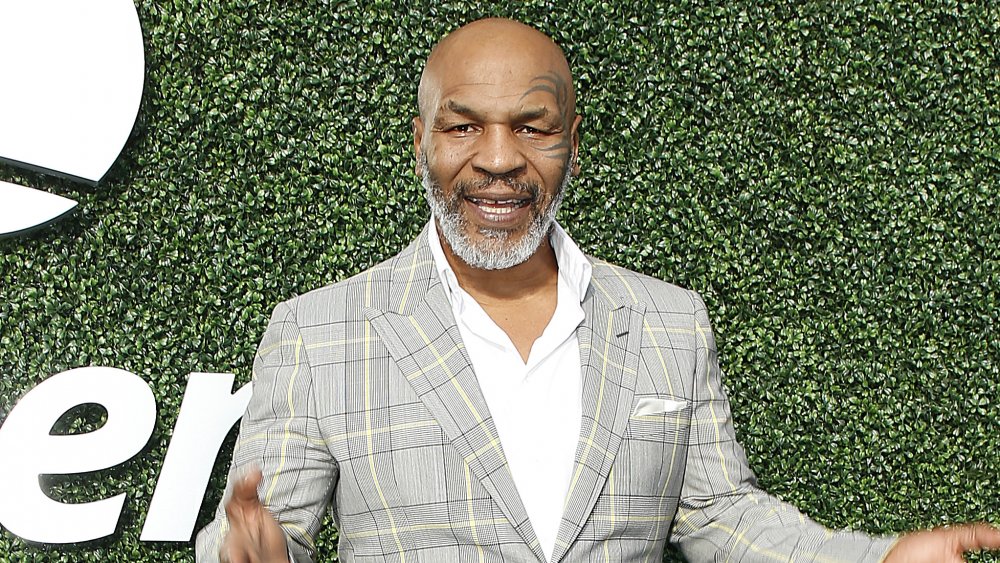How Mike Tyson Makes Money Now
In November of 1986, Mike Tyson became the youngest heavyweight champion in history at 20 years old, dominating Trevor Berbick in less than two rounds. He proved to be one of the most dominant and ferocious fighters of all time, striking fear into opponents even before they stepped into the ring. Yet, time isn't kind to many people, boxers even less so.
Despite his achievements in the ring, Tyson's career often took a backseat to his personal life. The fighter went through a messy public divorce and was convicted of multiple crimes, including a rape conviction that resulted in a six-year prison sentence and a road rage assault that got him a two-year sentence. In 2005, Tyson's once magnificent career ended with a whimper when he refused to come out for the seventh round in his bout with Kevin McBride.
Throughout his roller coaster life and career, one of Tyson's more intriguing storylines was about his finances. Despite earning some of the sport's biggest paydays in his career, Tyson experienced enormous financial difficulties. It came to a head in 2003 when he declared bankruptcy, claiming he was $23 million in debt. Without boxing purses coming in, how has he managed to stay afloat all these years? We decided to dig into the financials and find out how Mike Tyson makes money now.
From riches to rags
Mike Tyson's financial situation is difficult to grasp. According to Forbes, he is one of the highest-paid athletes of all time, earning nearly $700 million throughout his career. That number is especially shocking considering Tyson's 2003 bankruptcy claim and his current net worth of $3 million, as per Celebrity Net Worth.
In an interview with Graham Bensinger, Tyson spoke about his financial ruin. "I never really learned the art of handling money," he said. According to Bensinger's recap, in the 33 months following his release from prison, Tyson's spending habits shot into orbit. He spent $4.5 million on automobiles, $240 thousand a month on "walking around money," nearly $100 thousand a month on jewelry and clothing, $400 thousand on animals, $300 thousand on lawn care, and a house with 38 bathrooms. Tyson claimed that he was simply "reckless, young, and foolish."
Looking back on his former wealth, Tyson suggests he doesn't miss it as much as you might think. "You have it all, but there's still an empty hole that you're trying to fulfill," he told Bensinger. "You spend as much as you can to get that satisfaction, fulfill that hole, it's just, it's bottomless."
Boxing for charity
In May of 2020, Mike Tyson posted a video of himself training on Instagram, looking powerful and rejuvenated in short bursts. In the end, he looked at the camera and announced, "I'm back." This got the rumor mill going. How and where would Tyson make his return? There was talk about a third fight with Evander Holyfield, an offer to bare-knuckle box Wanderlei Silva for more than $20 million, and even some discussion about a Tyson vs. Tyson (Fury) fight.
The eventual landing spot for his return would be more surprising than any of the rumors that preceded it. In late July of 2020, the former heavyweight champion signed on the dotted line to fight Roy Jones Jr. According to TMZ, the purse is being funded by Triller, a social media app that put up $50 million for the fight. Jones Jr. claims that he can make more than $10 million, whereas Tyson claims that his cut will go to charity. "I'm not getting anything," he said.
While the fans are undoubtedly excited about the match between two Hall of Famers, some question its legitimacy and wonder if it might be dangerous. With both fighters over the age of 50, CBC calls it "an infomercial wrapped in a boxing match, perched precariously atop a pair of potential health catastrophes."
Wrestling down paydays
The boxing ring wasn't the only ring that Mike Tyson graced throughout his career. In 1998, while serving his suspension for biting the ear of Evander Holyfield, the heavyweight appeared on the WWE's big stage for the first time. It wasn't just any regular performance either. Some credit it for boosting ratings and saving a then-struggling WWE organization. According to wrestling historian Dave Meltzer, Tyson earned $3.5 million for the appearance, the largest sum paid to a guest celebrity in WWE history.
Tyson would return to WWE several times over the next decade-plus, even earning himself an induction into the WWE Hall of Fame in 2012. "I was the youngest heavyweight champion of all time," he said in his speech. "But the most fun I ever had in the ring was with WWE." In May of 2020, the friend of wrestling returned, this time to the AEW, to rehash an old storyline with former WWE star Chris Jericho from 10 years earlier. It has not been revealed how much Tyson earned for his latest appearance, but, if history has taught us anything, it was probably a smart investment.
From the ring to the big screen
When most people think of Mike Tyson's acting, the first thing that comes to mind is The Hangover. For many, this 2009 performance reintroduced them to a man they hadn't seen in quite some time. As for his part in the successful film, Tyson didn't even remember agreeing to be part of it. "I didn't know as I was drinking and smoking back then, doing drugs so I didn't know I was involved in the movie," he told The Sun. Still, it helped reignite his popularity. "When I go out and I meet younger kids that are 20 or 15 it's because they watched the Hangover," he said. "They had no idea that I used to be a boxer."
Since that film, Tyson has kept up a steady plate of roles. Most recently, he appeared in films, like A Madea Family Funeral and Pharaoh's War. For several years, he voiced his own character in the cartoon, Mike Tyson Mysteries. Unfortunately, the show's fourth season, which ended in February of 2020, was the last. For those looking for something closer to reality, they can find Tyson on Discovery Channel's "Shark Week" in a special called Tyson vs. Jaws: Rumble on the Reef.
Turning over a new leaf
In 2016, Mike Tyson and Rob Hickman founded Tyson Holistic Holdings. The company now owns and operates several cannabis-related ventures, including CopperGel, a topical analgesic with ingredients like camphor, menthol, and hemp oil. The company also invested in CHILL, a CBD-infused alkaline water company. Tyson isn't just the face of the company — he's a customer and a believer. "I've been fighting for over 20 years, and my body has a lot of wear and tear," he told Cannabis & Tech Today. "I had two surgeries and I used marijuana to calm my nerves, and it would take the pain away."
The former heavyweight also owns the Tyson Ranch, which partners with local cannabis growers, rents them land to grow on, and helps them brand and sell their products. This setup allows the company to keep its organization legal. According to Tyson, the company sells an enormous amount of marijuana as well. On his own podcast, he spoke about the financials, saying they sell $500,000 each month while also admitting that he and his friends smoke approximately $40,000 worth of product each month.
Hotboxin' with Mike Tyson
In early 2019, Mike Tyson entered the world of podcasting. His new show, Hotboxin' (co-hosted with former NFLer Eben Britton), talks with guests about a range of topics. Now retired from football, Britton is "a medical marijuana advocate and a holistic health proponent" ( via Tucson.com). The two met when Britton was asked to help Tyson put on a summit with a medical cannabis and sports panel. The podcast grew from that meeting. In the first episode, the hosts spoke with Dr. Gerardo Sandova about alternative treatments for mental health and addiction. They've had guests like Eminem, Snoop Dogg, and Sugar Ray Leonard.
It's difficult to nail down exactly how much Tyson's popular podcast brings in financially. According to iTunes Charts, the podcast peaked at #36 on the top 100 list. According to Bloomberg Businessweek, the top shows can earn more than $1 million each year. On Youtube alone, Tyson has nearly 1.5 million subscribers. Just by posting videos of his podcast on his channel, he can earn up to $5,000 for every million views, as revealed by Turbo Intuit. If every interview — roughly one each week — gets one million views, Tyson can earn up to $250,000 a year in addition to the podcast earnings.
The cannabis resort
In addition to the hosting growing facilities and office space, Tyson Ranch has developed plans for the centerpiece of Mike Tyson's cannabis-themed dreams, a 407-acre marijuana resort. According to The Leaf Desk, the resort is expected to include a luxury hotel, lodges, and a "glamping park," along with spas and the world's longest lazy river. The ex-boxer also hopes to break ground on "Tyson University," a facility that offers degree-style courses on agriculture and cannabis farming.
While guests are expected to be allowed to smoke marijuana at the resort in Desert Hot Springs, it does not have a license to sell the product. According to Los Angeles Magazine, the original plans were to open the resort in 2019, but it has since been delayed. To help pass the time and keep the excitement high, the ranch hosted the Kind Music Festival, a cannabis-themed event, in early 2019. Unfortunately for the Tyson team and event-goers, they "failed to get permission from Desert Hot Springs officials to allow for on-site consumption or sale of marijuana."
Endorsements from Kid Dynamite
When Mike Tyson was at his peak in boxing in the late 1980s, the endorsements were rolling in. After he won the heavyweight championship for the first time, Jim Jacobs, Tyson's co-manager, told the Los Angeles Times that the young boxer was just scratching the surface. "Mike will, if he continues as he has, make more money than any athlete in the history of this country," he said. He started off on the right foot. In addition to the $35 million for his fights in 1988, Tyson earned many millions more in deals with Pepsi, Nintendo, and Eastman Kodak.
But then, practically overnight, he lost them all. After Tyson's then-wife, Robin Givens, said that he was abusive, the champ became unmarketable. "He was going to sign a one-year Pepsi deal that could have earned him about $10 million. It was a huge deal," a former Tyson aide told The Los Angeles Times. "Then, just before the Spinks fight, the stuff came out about Mike hitting Robin and that was the end of Pepsi. In a very short time, all the endorsement deals were dead."
These days, his endorsements aren't as flashy, but they still exist, if only in small numbers. In 2019, for example, Tyson signed a 12-month deal with Parimatch, an international betting company. As Global Brand Ambassador, he would be part of the company's marketing materials and large-scale advertising campaign.
In the flesh
If you're looking to see Mike Tyson in person, there are a number of ways you might be able to accomplish that feat. Perhaps the easiest would be to book tickets for his one-man show, The Undisputed Truth. Written by Tyson's wife, Kiki Tyson, and directed by Spike Lee, the original show started a successful Broadway run in 2012. Later that year, they announced that it would be going on the road in 2013, spanning 36 cities in a 10-week period. He now runs select shows around the country.
You can also book Tyson to attend your next event, but it won't come cheap. His services can be acquired through Celebrity Talent International, for example, for a starting price of $75,000. Through AAE Speakers, Tyson can be booked as a keynote speaker on topics that include mental health, inspirational talks, family and parenting, and boxing. The starting price for his in-person services starts at $200,000. While Tyson may not be the most eloquent or professional speaker, his life and experiences do put him in a position to connect with audiences and situations in a way most people cannot.
The Mike Tyson biopic
For a time, it seemed the Mike Tyson biopic was shelved permanently. Originally announced in 2014, the film was to star Jamie Foxx and have Martin Scorsese direct it, but it never took off. Now, it seems to be back on the front burner. In 2020, Foxx confirmed the news by showing off his early-stage body transformation in preparation for the role. According to The Sun, Foxx's workout regime included "60 pull-ups, 60 dips, and 100 press-ups." As for the lower half of his body, that might be a problem. "I ain't got no legs," he said. "I ain't got no calf muscles so we're gonna have to get some prosthetics for that."
Regarding the film's content, Foxx told Mark Birnbaum that it would cover the highs and lows of the boxer's career and life. "We want to show everybody evolves," he said. "Everybody comes from a good or bad place and I think when we lay the layers on Mike Tyson in this story, I think everybody from young and old will be able to understand this man's journey and the way we'll place it." Tyson is confident in Foxx, an actor who won an Academy Award for Best Actor for a biopic. "He can do a great job I know that," Tyson said. "I'm gonna sit down and tell him the truth and he's gonna have to learn to process that. It's not going to be pretty."

